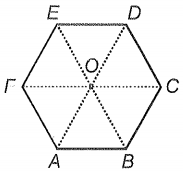\(\overrightarrow A\)
1. \(\frac{(2\hat i -\hat j)}{2}\)
2. \(\frac{5}{2}(\hat i - \hat j)\)
3. \(\frac{5}{2}(\hat i + \hat j)\)
4. \(\frac{(3\hat i -2\hat j)}{2}\)
If a vector is inclined at angles \(\alpha ,\beta ,~\text{and}~\gamma\), with \(x\), \(y\), and \(z\)-axis respectively, then the value of \(\sin^{2}\alpha+\sin^{2}\beta+ \sin^{2}\gamma\)
is equal to:
1. \(0\)
2. \(1\)
3. \(2\)
4. \(\frac{1}{2}\)
If is the unit vector in the direction , then:
1.
2.
3.
4.
Which of the following sets of forces cannot give zero resultant?
(1) 3 N, 4 N, 5 N
(2) 9 N, 8 N, 7 N
(3) 16 N, 2 N, 17 N
(4) 30 N, 5 N, 24 N
If two force vectors of the same magnitude are arranged in the following manner, the magnitude of resultant is maximum for?

(1) (I)
(2) (II)
(3) Both (II) & (III)
(4) Both (I) & (II)
The minimum number of non-coplanar vectors whose vector sum can be zero is:
(1) 2
(2) 3
(3) 4
(4) 5
The resultant vector of makes angle with and with .Then-
1.
2.
3.
4.
The figure shows ABCDEF as a regular hexagon. What is the value of ?

1.
2.
3.
4.
A vector , which has magnitude 8.0 is added to a vector which lies on the x-axis. The sum of these two vectors lies on the y-axis and has a magnitude twice the magnitude of . The magnitude of the vector
1. 8
2.
3.
4.


